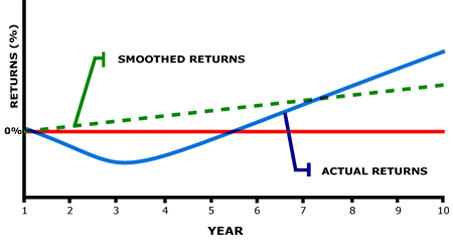Entrepreneur and Business Resources
Integral Methods and Technology
Governance and Investor Responsibility
|
Understanding Private Equity Performance
From Calpers.ca.gov
http://www.calpers.ca.gov/index.jsp?bc=/investments/assets/equities/aim/private-equity-review/understanding.xml
The J-CURVE Effect: Earning Acceptable Returns Takes
Time
In the early years, private equity funds will show
low or negative returns. The investment gains usually come in the
later years as the companies mature and, with the help of the General
Partner, increase in value. The effect of this timing on the
fund's interim returns is known as the J-Curve
Effect.

In the initial years, investment returns are negative due to management fees, which are drawn from committed capital, and under-performing investments that are identified early and written down. It can take several years for the portfolio valuations to reflect the efforts of the General Partners. Over time, progress is made by investee companies and justifies a value for the business that is higher than its original cost, resulting in unrealized gains. In the final years of the fund, the higher valuations of the businesses are confirmed by the partial or complete sale of companies, resulting in cash flows to the partners. In practice, a private equity portfolio involves a series of J-Curves because funds are invested in at different times. However, not all funds will be profitable given the inherent risks of investing in private equity, including macroeconomic factors and the performance of underlying companies.
Valuation & Performance Measurement
In the
first year of a private equity fund, investments are carried at cost.
In subsequent years, the sale of portfolio companies or public
offerings of their shares results in cash and/or stock distributions
to the
Limited Partners. Over time, increasing proportions of a fund's
performance reflects actual cash distributions received, rather than
valuation estimates. The most widely used measure of performance is
the internal
rate of return (IRR). The calculation of the IRR takes into
consideration the timing of cash contributions and distributions to
and from the partnership and the length of time an investment has
been held. Another widely accepted measure of performance is using
an investment
multiple. This measures the proceeds received from a fund plus
the valuation of the remaining investments divided by the capital
contributed to the fund.
Although the General Partners report valuations to the Limited Partners quarterly, we monitor fund activities on an ongoing basis through regular communication with the General Partners. While there are no current industry standards for valuations, reporting, and performance benchmarking, we are focused on working with industry associations (such as the Institutional Limited Partners Association and AIMR) to address these issues.
Since inception in 1990 to September 30, 2003, the AIM Program has generated $4.9 billion in profits for CalPERS. Given the young, weighted-average age of the portfolio (4.6 years) this amount will continue to grow as the portfolio matures.